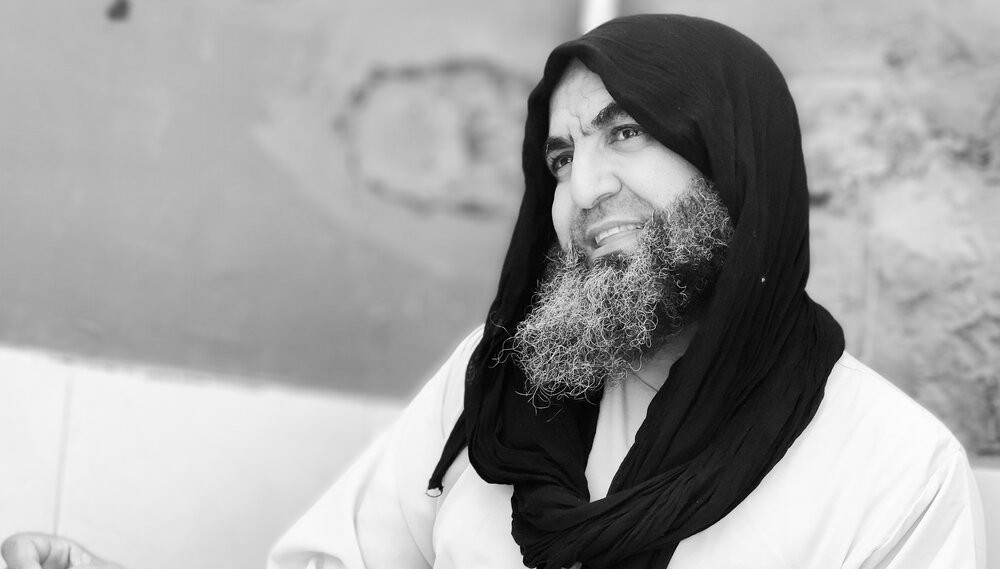Book
AN EXCERPT FROM
AT THE
SERVICE
OF DESTINY
A Biography of the Living Moroccan
Sufi Master Shaykh Mohamed Faouzi
al-Karkari, may Allah sanctify his secret
By his disciple Jamil Zaghdoudi
Translated from the French
by Edin Lohja and edited by
Dr. Yousef Casewit
Originally published by Les 7 Lectures
CHAPTER: Succession
When Shaykh Mūlāy al-Ḥasan passed away, our Shaykh inherited the status of the Shaykh of the Path despite the fact that this did not look obvious after Mūlāy al-Ḥasan’s death.
Then he reached the highest stations and became a person towards whom all men and jinn seeking guidance were directed, without anyone knowing that he was a Shaykh.
He says, “I attained to a level of nearness and knowledge after the death of my Shaykh that he had not achieved himself during his lifetime.” He con- tinued in this way until the Real honored him with the station of Seal (khatmiya), which is in reality the heritage of the divine names and of Muḥammadan Successorship, (al-khalīfa al-Muḥammadi).
He said, “The authorization to become spiritual master (mashaykha) was made first by the Shaykh, then by the Prophet صلى الله عليه وسلم personally, and then by God.” He then added, “We never sought to become a Shaykh, this fell upon us without us desiring it. It is a divine bestowal (hiba).”
He said, “The permission (idhn) of this Path is from Ibn Mashīsh (mashīshīyya), for among all the Shaykhs of the initiatic chain (silsila), the only one to transmit the Light of allegiance (bayʿa) as we do was Shaykh Mūlāy ʿAbd al-Salām Ibn Mashīsh.”
He said, “I saw the collectivity of my disciples giving me the oath of allegiance in the spiritual realm, I know them all. I know their beginning, their end, whether they are among the felicitous (saʿīd) or the wretched (shaqī), the stations they will occupy, and most incredibly, I still remember each of them.” In fact, a man from Belgium wanted to meet our Shaykh during his visit to Europe.
When Sayyidī Shaykh saw him, he told us, “He will not enter the Path, for when a disciple comes to us and we recognize him, our heart starts to quiver.” This person visited the Shaykh at the al-Aroui zāwiya and left after a week without asking to join the Path. Then we had no news of him.
He said, “On the night of 12 Rabīʿ al-Awwal 2007 I had a vision that made me reach the status of Shaykh. Contrary to what many think, the oath of allegiance (bayʿa) is a descent and not an ascent. It descends (nuzūliyya) from the Lord to the servant. This vision came about in the sensorial world. I saw myself receiv- ing the oath of allegiance (bayʿa) from God, then the Prophet صلى الله عليه وسلم took allegiance (bayʿa) from me, and then Sayyidunā ʿAlī, and then al-Ḥasan and al-Husayn in the presence of their mother, Fāṭima al-Zahrāʾ. Then I saw all the Shaykhs of the blessed initiatic tree, one by one, coming to take the oath of allegiance (bayʿa) before me. It was while I was passing from one Shaykh to another that the reality of the hidden Supreme Name manifested itself to me. The scene was so terri- fying that I escaped. I ran away and refused it. I took flight until I found my Shaykh, Mūlāy al-Ḥasan who took out the rosary of one thousand beads (subḥa alfiyya) and made me accept it. Then the Supreme Name and the secret of the Essence appeared. At that very moment hatred was removed from my heart, and there remained nothing but love for the whole of creation. That is the reason why a Shaykh never judges his disciple, even though he may know his lowest thoughts and his basest intentions. Thus, a Shaykh’s love outstrips a disciple’s love. This is the reason why a Shaykh may initiate and guide a disciple even if he is found in the middle of the ocean, for they have given their allegiance (bayʿa) to us in the spiritual realm (malakūt).”
Sīdī Mohamed Faouzi – may God sanctify his secret – spent a year alone, unknown by anyone, in complete obscurity (khumūl), so much that even his wife knew nothing about his state. She would see him wake up, make the ablutions, sit in the direction of the Kaʿba (qibla), and perform invocation (dhikr) for hours. He was looking for someone to share the secrets of the Essence, for when the secret dwells in the heart the tongue cannot remain at rest.
He says, “I prostrated myself and asked Him, ‘A single person ... just one... I only ask Thee for a single person that I may converse with him.’”
His mother, lalla Yamna, and his brother, Sīdī Abdel-Nasser knew that he had become a Shaykh and that he had received the authorization to transmit the teachings of the Path. Both wanted to join the Path at his hands, but he repeatedly avoided their requests. Sīdī Abdel-Nasser said, “When Mūlāy al-Ḥasan passed away I was afraid of plummeting. I would visit Sīdī Shaykh often and ask him to allow me to join the Path. I continued to ask continuously until one day he gave me the litany (wird) which then did not contain chapters from the Qurʾān. Thus I became the first disciple of the Karkariyya branch.”
I heard Sayyidī Shaykh say, “My mother asked me to initiate her but out of modesty I avoided respond- ing. How could I be the Shaykh of my own mother? Yet, she had grown up in the zāwiya of Mūlāy Ṭāhir, she knew the value of bay’a, so she persisted until I initiated her. She died a short time afterwards, with her head on my lap, invoking the Name Allāh.”
Sīdī Muḥammad b. Siniy Taibi told us, “After Mūlāy al-Ḥasan’s passing I asked his son, Nourredine, if we had to renew the wird with him. His response was, “No, the wird is that of my father.” We had gone to see Sīdī Shaykh Mohamed Faouzi al-Karkarī to ask him if he was a Shaykh. He declined to answer. Each time I would come across him I would ask him if he was a Shaykh, and he would not reply, until one day he told me, ‘Yes, I am a Shaykh.’”
A year later came the obligation of calling others to God (daʿwah). Were he to refuse, everything would be taken away from him.
He said, “The more a Shaykh desires to remain in obscurity, the greater his outward exposure.” When he received the obligation of daʿwah he said, “I went to the rocks to make daʿwah to them, but they told me to go to men. Whenever I heard good words about someone I would visit him for daʿwah.” The begin- nings were difficult, and he had to tolerate the evil and mockery of many a person. One day, as he was exiting the mosque a wretch appeared who spat on his noble face.
Our Shaykh did not even think of revenge or returning the insult. On the contrary, he wiped his face and continued his way. The first disciples to join our Shaykh were those who had followed Mūlāy al-Ḥasan – may God be pleased with him – in his lifetime, namely our Shaykh’s mother, lalla Yamna, Sīdī Abdel-Nasser al-Karkarī, and Sīdī Muḥammad b. Siniy.
Sīdī Abdel-Nasser brought Sīdī Said Menouach to the Path, who was then seventeen. Then it was the turn of Sīdī Ḥājj Muḥammad Fadhil, our Shaykh’s wife, lalla Najet, Sīdī Aḥmad Boutaba, and Sīdī Aḥmad b. Ṭayyib, our Shaykh’s brother.
Sīdī Ḥājj Muḥammad Fadhil told me once, “We had heard that Sayyidī Shaykh had made the spiritual retreat (khalwa) with Mūlāy al-Ḥasan, and it was through that retreat that we entered the Path. At the beginning of the Path, when we were only four or five disciples, we used to gather in the dentist office of Sīdī Mūlāy Abdel-Nasser, our Shaykh’s brother, and we would spend entire nights and days with him. Whenever the call for prayers would be announced we would go to the mosque, and then return to the office. During the summer, we would gather at the inner courtyard of the marketplace, under a tree, in order to listen to Sayyidī Shaykh’s discourses (mudhākarāt).
Without a zāwiya and a gathering place, Sīdī Shaykh said, “The first course that we held was a commentary of Shaykh Aḥmad al-ʿAlāwī’s poems, followed by a commentary of Imām Ibn ʿAṭāʾ Allāh al-Iskandarī’s aphorisms. During almost two years we explained the meanings of the aphorisms to the fuqarāʾ. We who did not understand any book became expositors of books... We gave such importance to those two books that after completing their com- mentary, Shaykh Aḥmad al-ʿAlāwī and Imām Ibn ʿAṭāʾ Allāh al-Iskandarī – may God be pleased with them – came to thank us in person in the spiritual realm (malakūt). Shaykh Aḥmad al-ʿAlāwī then ena- bled us to visit his zāwiya in Mostaghanem, and he showed us how he slaughtered a ram to inaugurate his zāwiya, which is why we slaughtered a ram too for the inauguration of our zāwiya.”
The Path was quite different from what the disciples know today. Upon initiation each of them received one of the sixty-three allusions (ishārāt) corresponding to the years of the Prophet’s صلى الله عليه وسلم lifetime in this world. The contemplation of that spiritual allusion was sup- posed to lead the disciple to the vision of Light. Only then could he enter into khalwa. Sayyidī Shaykh said, “The first four disciples that I put into khalwa were all under the spiritual direction of Sīdī al-Ḥasan, and it was he who told me how to proceed with them.”
Back then, the room in which most of the disciples now make the khalwa had not been constructed yet. The first disciple who made a khalwa, Sīdī ʿAllāl, had to use a room in Mūlāy Ṭayyib’s house.
The first twelve disciples who made the khalwa were: Sīdī ʿAllāl, Sīdī Abdel-Nasser, Sīdī Ahmed (Sīdī Shaykh’s brother), Sīdī Said Menouach, Sīdī Muḥam- mad b. Siniy Taibi, Sīdī Ḥājj Muḥammad Fadhil, Sīdī Abdel-Hafiz Ribāṭī, lalla Najāt, Ḥājj Taieb Chérif alias al-Ouadi, Sīdī Aḥmad Boutaba, Sīdī ʿAzīz, and Sīdī Abdel-Hamid. All of them experienced spiritual open- ings from which they benefited greatly. The Lights of the divine proximity and the brightness of supreme knowledge appeared to them. Sayyidī Shaykh says, “Our Path is one of vision in wakefulness, and who- ever does not achieve vision I am not their Shaykh and he is not my disciple.” Thus, the Path began to take shape little by little until his fame crossed bor- ders and oceans. Our Shaykh continued to teach the secrets of the Name Allāh in his zāwiya which is still located in al-Aroui.



